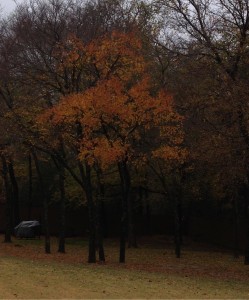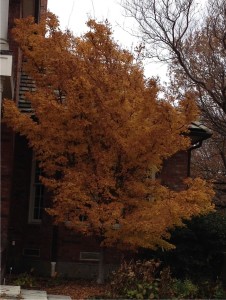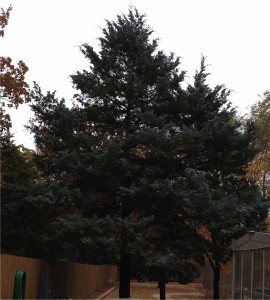This has been such a beautiful fall with all the trees in bright, brilliant colors. We have a yard of cedars, oaks, and cedar elms. Of course, the cedars are evergreen but they produce masses of lovely blue gray berries every fall. One of our oaks is a bright red, but most are just brown at this time of the year. The most colorful are the cedar elms with their bold golden leaves that flutter to the ground when it rains or the wind blows. Right outside the bedroom window is a coral bark maple, an unusual tree we planted when we built our home. Right now the leaves are a bright yellow, but when they fall the bark turns red, hence the name. On a cloudy or foggy morning the red bark almost glows.
With the exception of the coral bark maple, a couple of Japanese maples, and three magnolias, all of our trees are natives. Some were here when Jacob Dunn patented the land in the early 1850s. It was this strip of wooded land that made it so popular when the early pioneers arrived in Hunt County.
There were three necessities to consider when choosing a site to patent. First, the soil must be fertile. Tall grass was the key factor. The second was access to adequate water. One must remember that it is impossible to compare today’s creeks and streams with those here in the first half of the 19th century. Dams and lakes have fairly successfully served their purpose to provide flood control and provide large bodies of water for human use. With that said, many of the local creeks held water longer than they would today.
Early settlers also used cisterns to collect rainwater, a trend that is becoming popular again with gardeners. Wells were dug in parts of the county with sub-surface water. Others cobbled up a skid to hitch to the oxen and took a wooden barrel to a spot where water was deep enough to fill the barrel. Then the oxen hauled the barrel home on a contraption much like Santa’s sleigh, but designed for grassy pastures, not snowy woods.
The third requisite was a good source of timber for constructing homes and barns, as well as providing fuel for heat and cooking. Looking at a plat map of Hunt County, one is able to see that the large landowners chose most of their land on the rolling prairies of the central and western parts of the county. For the most part, this was black land, that fertile soil good for growing cotton, hay, wheat, and forage for livestock. But throughout the county landowners claimed small strips of land a considerable distance away from their farms. When firewood or logs for building were needed, they hitched the wagon to the faithful oxen, took young sons, and went to the woods found on these small strips to chop timber. This was often done two or three times each year, especially in autumn when the weather was turning cold. The men and boys camped out for a couple of days, gathered all the wood that would fit in the wagon, and then started home.
No one ever said pioneering was easy. But I wonder if our ancestors took the time to marvel at the autumn beauty so as we have seen this year.



